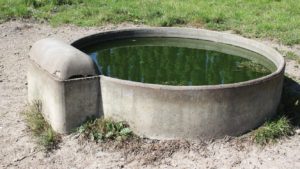In the late 1960s, thanks to research done by Campbell and Munford of Massey University, it was believed cows could drink enough water at the dairy before or after milking to satisfy their daily needs.
To be fair to farmers, polyethylene pipe, which is the trademarked Alkathene pipe, just started to appear at the 1970s RD1 and Farmlands stores and if it was nearly impossible to run metal pipes over hills to water troughs in every paddock, no doubt the research made it easier to sleep at night.
Cows also had mostly unimpeded access to creeks and rivers to drink from as there were no fenced-off buffer zones planted out in native trees.
However, since then we’ve figured out that fencing off the waterways is good for the environment and clean water and lots of it which can be accessed 24 hours a day is essential for cow health and milk production.
It’s in New Zealand’s Animal Code of Welfare for Dairy Cattle (page 11 if you’re looking) and the minimum standard is all dairy cattle must have access to a daily supply of drinking water sufficient for their needs that is not harmful to their health.
The water delivery system must be reliable and maintained to meet daily demand and in the event of a water delivery system failure, remedial action must be taken to ensure that daily water requirements are met. Note this is for all dairy cattle, not just the milking herd. Under recommended best practice the code adds troughs should be cleaned and maintained regularly, water should be palatable, the quality monitored and the farm water supply should be able to meet peak demand of 14 litres/milking cow/hour at the trough.
Take that Campbell and Munford.
And it’s in early summer, when it starts to get hot and your herd numbers might have increased from last year, you will notice if your water supply is not good enough. Cows pushing and shoving around the water trough with their heads well in is a sure sign you need to do something and fast.

This is not a to-do-job to put up on the white board in the milk room along with spraying weeds and filling potholes on the tanker track.
And if you need some encouragement to fix the problem, it’s just not about animal health and welfare. You will notice it in the vat.
And cows fighting for water will damage ballcocks and troughs meaning costly and time-consuming repairs.
So have a look at your whole water system including the size of each paddock’s water trough and how fast it fills. Volume and pressure are both important – if you have low water pressure you need more troughs per paddock or bigger troughs and bigger pipe diameters.
A ring main system, where the water line is in a loop with both ends fed from the source, can help to increase water pressure.
Time how fast your trough refills and do the maths. A milking cow needs about 80 litres of water per day so if you have 300 cows in the paddock for 12 hours they will need a minimum of 12,000 litres (300 x 40 litres) which is 1000 litres/hour or about 20 litres/minute. If your flow rate into your trough is less than this you have a problem.
So check your cows in the midday heat to make sure they are getting enough water, check your water trough every time you take the cows out of a paddock to make sure it is working properly and if you have a patch in a paddock that always stays green it might just be where you have a water line leak so dig it up and fix it.
It’s estimated even a hole in a water line the size of a nail will mean you’re losing 14,000 litres of water a day. If you are paying for water, electricity to pump the water and you’re adding minerals, that’s a lot of money going nowhere.
And if you haven’t got enough water getting to your trough, fixing that one hole could solve the problem.
Measure your trough water usage and record it. It won’t pick up the existing leaks but over time it will show you when new ones start.
Have a farm map showing the farm’s waterlines, troughs, taps and isolation valves in the milk room where it’s easy for all farm staff, and contractors, to see. Include the pipe diameters on the map so if new fittings are needed the right ones are bought.
And include in the four-wheeler kit an extra ballcock arm, string, thread seal tape and split pins so repairs can be made on the spot and train your staff how to do them.
Check water troughs are clean (you should be able to see the bottom of the trough) and, if any are at ground level, lift them up as they can become easy traps for hedgehogs and other small mammals.
There is not a lot worse when baling out a trough to find a bucket full of tiny bones.
Turn the water off to the trough, bail it out with a bucket and leaving it empty for a few hours on a sunny day and any algae present will be gone.
Test your water for iron and salt. Cows don’t like the taste of too much of either and will drink less. Fixing the problem will increase milk production.
And make sure you know where your water comes from and become involved in the scheme, provider or whatever it is.
Government’s plans for Three Waters (drinking water, stormwater and wastewater) are still vague but may one day include your scheme. Who wants someone, in an office far away, deciding who gets what and how much you will have to pay for it?
For most regional councils, taking stock water is a permitted activity and does not require a consent unless it has an adverse effect on the environment (affecting river flows/other bores).
However, it always pays to check and council’s consent teams are usually helpful and should be your first call, before you get in a consultant.
Knowing how much you are using for stock water will also help the process.




